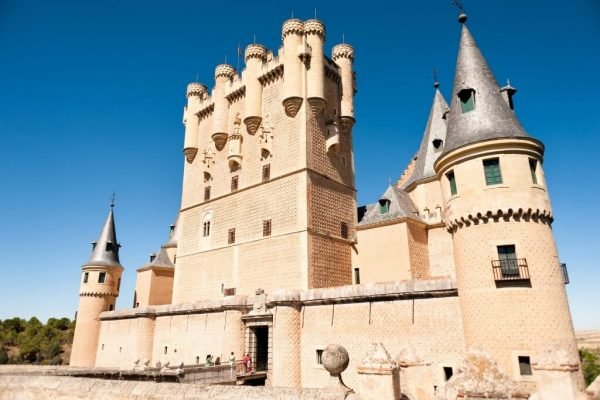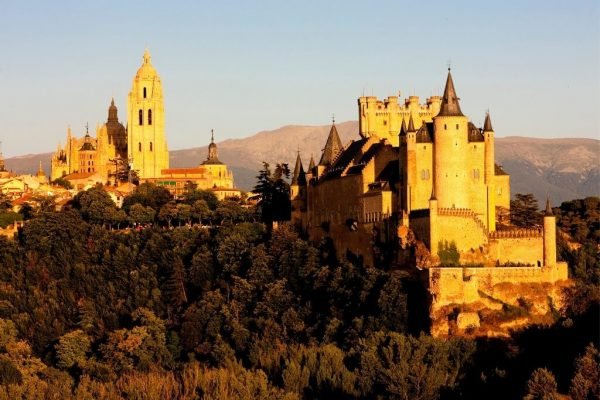Excursion to Avila and Segovia from Madrid
PEPE TOURS
Excursion to Avila and Segovia from Madrid
PEPE TOURS
Full-day coach trip to Avila and Segovia with English speaking guides
Full day excursion departing from Madrid to visit Avila and Segovia, the jewels of Castile and Leon, one of the Spanish regions with the greatest cultural & ethnographic heritage and natural wealth, declared World Heritage Cities by UNESCO in 1985. Avila preserves a unique historical legacy, being one of the best preserved walled sites in Europe. Segovia is world-famous for its impressive Roman aqueduct, the Gothic cathedral or the Alcazar Fortress. We invite you to experience a wonderful excursion accompanied by official tourist guides who explain the history of these two beautiful cities, their monuments, characteristics and traditions, travelling by modern, fully air-conditioned coach.
Departure from our terminal heading to Segovia, a dream city with unique architecture. Chosen by some Kings of Castile as their residence, it preserves one of the most notable medieval ensembles in Spain. Upon arrival, we will take a guided walk through Segovia that will take us from the iconic Roman Aqueduct, a masterpiece of ancient engineering, to the heart of the historic centre. We’ll stroll along charming medieval streets and admire several notable landmarks from the outside. Among them is the Casa de los Picos, one of Segovia’s most famous buildings, with a façade covered in more than 600 diamond-shaped granite blocks that give it its distinctive look. We continue to the Plaza de Medina del Campo, where we find the Church of San Martín, a beautiful Romanesque temple, along with several Renaissance palaces like the Casa de los Solier and Casa de Bornos, reflecting the importance of this plaza in past centuries. Our next stop is Plaza Mayor, the city’s vibrant heart, surrounded by architecturally significant buildings, traditional shops, cafés, and restaurants. The most prominent structure here is the Cathedral of Segovia, the last Gothic cathedral built in Spain and considered by many the Lady of Spanish Cathedrals for its elegance. We’ll end our walk at the gates of the Alcazar of Segovia, one of the most spectacular castles in the country (entrance not included) – a fairy-tale fortress with pointed towers and breathtaking views. You’ll also have the optional opportunity to visit the Cathedral’s interior to further enrich your experience.
After the visit, we will enjoy free time to have lunch and shop for souvenirs. Optionally, you can enhance your experience by adding a meal at a local restaurant, tasting the famous Segovia roasted suckling pig, one of the most emblematic dishes of Castilian cuisine and a symbol of the city.
Next, we will head to Avila. Its massive Romanesque wall from the 11th century surrounds the old city and guards much of its monumental treasure… more than a city, it feels like a large castle. It boasts a great number of Romanesque churches, Gothic palaces, and a 12th-century fortified cathedral. Here, Saint Teresa of Jesus, a great mystic of the Catholic Church, was born. With our guide, we will take a tour of the exteriors of the Plaza del Mercado Chico, the heart of the historic centre of Avila, surrounded by arcades and stone buildings, where the Avila Town Hall, an elegant neoclassical building, and the San Juan Bautista Church, where Saint Teresa of Jesus was baptized, stand out. We will also see from the outside the Cathedral of Avila, one of Spain’s most impressive architectural gems and the first Gothic temple built in the country. In front of the cathedral, we will find the Palace of Velada, a majestic Renaissance building, restored and converted into a luxury hotel. We will end the visit in front of the Basilica of San Vicente, one of the most important and emblematic temples of Avila, considered a jewel of Spanish Romanesque. It stands outside the city walls, at the site where, according to tradition, Saints Vicente, Sabina, and Cristeta were martyred in the 4th century. Optionally, the Ávila Wall can be visited.
After a day full of history and beauty, we will begin our return to Madrid, bringing with us the memories of two unforgettable cities.
Departure days:
Friday, Monday, Saturday, Sunday, Thursday, Tuesday, Wednesday
The excursion to Avila and Segovia includes:
– Travelers insurance
– Round trip bus transportation from Madrid
– Panoramic tour by bus
– Guided walking tour through the old town of Avila and Segovia
– Entrance tickets to the Alcazar Castle in Segovia
– Accompanying guide throughout the trip
– Lunch if requested
Price details
| PRICE PER PERSON IN EUROS (SEASON 2025 - 2026) | |
| ADULT | from 69 € |
| CHILD (3 – 11 years) | from 42 € |
More information about Avila & Segovia
Avila
Avila was declared World Heritage in 1985 and preserves an historic legacy which is unique worldwide. Its walls of more than 2,5 kilometres converts it into an easily recognizable Castilian and medieval city, the result of coexistence between Jews, Christians and Muslims. The Avila architecture ranges from Gothic to Renaissance, without forgetting Islamic marks through Mudejar. Its facades are characterized by a decentred door with a window or balcony above it. This grouping of houses had to do with lineage, but above all with defensive reasons, that is why they are linked to the city wall. The continuous fighting determined that some of these houses were fortified towards the inside, configuring real fortresses. The most characteristic elements of this Romanesque wall are its 2.5 kilometres of perimeter, 88 towers and 9 gates, two of which must be visited: The Gate of San Vicente and the Gate of Alcazar.
According to Azorin, “Avila is amongst all Spanish towns, the most 16th century one”. The town may presume of a rich civil architecture, built between the end of the 15th and the 16th century. For the town it was a period of maximum splendour, and still about 30 houses are preserved that confirm the importance of the nobility. Furthermore, mysticism and spirituality have a leading role, led by the figure of Teresa de Cepeda y Ahumada. There are dozens of cathedrals, churches and palacios worth visiting.
The location of the Cathedral of Avila reminds us of its link with the city wall, determining its fortified character. The construction was started in the Romanesque period, but finally it was constructed according to the gothic parameters, converting Avila in one of the first Castilian towns to explore this style.
Segovia
Segovia was declared World Heritage in 1985 and has worldwide fame because of its impressive Roman Aqueduct. But in this Leon Castilian town the tourist can also contemplate other historic monuments such as the Gothic Cathedral, the Alcazar, the Tower of San Esteban, the Monastery “del Parral”, the Synagogue of Corpus Christi, just like a great number of small temples in Romanesque style.
The Aqueduct. This is one of the most spectacular legacies the Roman Empire left behind in Spain. A total of 166 arches compose this aqueduct with a length of more than 17 kilometres, which transported water from La Acebeda to the Alcazar, challenging gravity as only the balance of forces maintains this structure that dispenses with mortar. Legend has it that it was the devil who constructed the aqueduct in only one night in order to obtain the soul of a young girl who had thus tempted him: “I offer you my soul if you can have water reach my house before a rooster crows”
The Cathedral. The apse of this temple, whose construction started in 1525, frames the Plaza Mayor and marks the limit with the Old Jewish Quarter. Inside, the stand glass windows of the 16th century stand out, as well as the Main Altarpiece designed by Sabatini.
The Alcazar. The splendid views of El Pinarillo (with the Jewish cemetery), Zamarramala and the Vera Cruz church are a more than sufficient reason to visit the old fortress, converted in royal residence since the 13th century. A deep moat with drawbridge gives entrance to this fortress, from whose turret Alfonso X studied the firmament. On its left, the Casa de la Quimica, built in the period of Illustration and centre of investigation of Louis Proust.
Observaciones
Exceptionally, the itinerary and the order of the excursions could be altered and modified for organizational reasons. You may choose between 3 options:
1. Excursion to Avila and Segovia without lunch.
2. Excursion to Avila and Segovia with tourist lunch.
3. Excursion to Avila and Segovia with gastronomic lunch.















